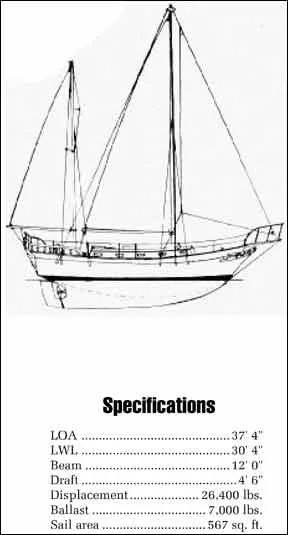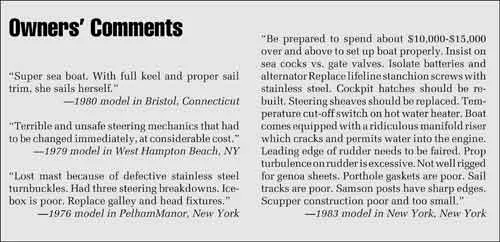During the late 1970s, when Taiwan-built boats began to appear on the U.S. market in increasing numbers, few boats better illustrated the Far East yacht than the Island Trader 37 or 38. (Same boat, different name depending on which brochure, in which year, you read.)

Imported to the U.S. by Marine International of Bay Head, New Jersey, between about 1977 and 1988, the Island Trader line apparently embodied the general misconception of what a real oceangoing boat should look like: Clipper bow, taffrails, pinrails, wooden spars, and enough spring in the sheer to mimic the curl of a breaking wave. And don’t forget the interior teak carvings of five-clawed Chinese dragons (symbol of good luck), poppy flowers and Dr. Fu Manchu.
You can’t exactly trace these designs to some turn-of-the-century Scandinavian lifeboat design; in fact, the designers seemed to have invented their own history, a history without a past.
The Design
Good subject. Who did design this boat? You won’t find any names on the brochures or in old sailboat magazine directories. William Garden gets at least occasional credit for the infamous Island Trader 41, built by a handful of yards and variously called the Yankee Clipper 41, Formosa 41, CT 41 and Sea Wolf 41. Did some American broker/distributor pen the lines, or, more likely, did some Taiwan builder flash the molds sitting behind his cousin’s chicken coop?
Maybe even he doesn’t even know who designed the boat, or if he did, he darn sure doesn’t want to pay royalties. Taiwan, in the early days of fiberglass boatbuilding, had the unsavory reputation of freely modifying plans to avoid unnecessary expenditures. In this culture, everything’s fair in love, war and business.
In profile, the Island Trader 37 looks like she caught a wave on the chin. The sheer seems exaggerated, rising too high in the bow and stern.
The low-aspect rig is short, carrying just 567 square feet of sail on a 30′ 4″ waterline. Displacement is reported anywhere from 18,600 lbs. to 26,400 Lbs. Holy cow! Did we say twenty-six thousand, four hundred pounds? This gives the 37 an incredible displacement/length ratio of 422, and an abominable sail area/displacement ratio of 10.7!
Lastly, check out the keel. This is the literal and pure conception of “full keel.” (Maybe the Island Trader does have a 19th century heritage after all!) At the least, we’d like to see the forefoot cut away to reduce wetted area.
Construction
Typical of this era, the Island Trader 37 hull is solid fiberglass, and has lots of it. One owner of a 1982 model, responding to our questionnaire, said he was “bounced around by a small whale without damage.” Other owners, too, praise the heavy construction, alluding only to mysterious defects: “Chinese glass work needs some help.” Or, “Chinese ‘stainless’ is interesting.”
But it’s the teak that invariably draws interest. And, of course, there’s lots of it. Though more than capable of first-class work, the Taiwan yards don’t always deliver a first-class product. The owner of a 1979 model said, “The finish work (teak), while plentiful, is only fair.” Others, however, noted that some care had been taken in matching grains, and that the joinerwork was for the most part good.
The owner of a 1983/84 boat wrote us a lengthy note saying, “Some models built in the 1970s had plywood cabins that rotted, giving bad name to company. Boat had a few minor oversights that were easily corrected. Protruding chainplates on outside of hull and a wide (3-1/2”) caprail of unvarnished teak were subject to abrasion. Therefore, I faired out the teak caprail to extend outboard of the chainplates, then installed 3/4″ x 3/8″ half-round brass rub rails on the full length of the caprails.

500
The inappropriate use or handling of plywood is another dubious trademark of early Taiwan boats. We’ve often seen cockpit seats made of plywood with teak on top and sprayed gelcoat underneath to make them look like fiberglass; they don’t last too many years before moisture delaminates the plywood, busts through the gelcoat and reveals the horrendous soggy mess. We’re not sure how the seats of the Island Traders were made, but we’d check them closely, too, especially since one reader said his needed reconstruction.
Respondents to our questionnaires report a number of other endemic problems: gate valves instead of sea cocks, poor quality turnbuckles, poor quality sheaves for the cable steering system, poorly designed exhaust system that can lead to engine damage, inadequate support for the rudder stock, and wiring problems, such as connecting the engine starter directly to one battery.
Based on an inspection of Taiwan boatyards about nine years ago, we think there are two principal causes of such misguided efforts: inadequate supervision by American marketers, and inadequate knowledge on the part of the Taiwan workers.
While the best yards, such as Ta-Shing, now rate well against American and European builders, there still are a lot of backyard builders who do things the old-fashioned way, which for the most part means outdoors using the cheapest, most easily available materials. During our visit, we seldom saw workers using power tools. Often a group of workers travels from one shed to the next doing carpentry, metal or electrical work for various yards. One day it’s Hans Christian, the next it’s Island Trader. And to expect that such people understand, let alone have ever heard of, the American Boat & Yacht Council standards for, say, color coding wiring or sea cock installation, is unrealistic.
The bottom line, we feel, is that with good management and supervision, Taiwan can produce quality boats. But judging from the litany of problems associated with Island Traders, we think owners of these boats are likely to get more problems than they’ve bargained for.
Performance
Earlier we noted that the displacement/length ratio of the Island Trader 37 is 422 and a sail area/displacement ratio of 10.7, easily putting it in the “heavy” or “motorsailer” category. With its short, divided rig, we would not expect sparkling performance.
Owner reports bear out this assumption.

Owners consistently rate the 37 as slow upwind and only average off the wind; we think they’re probably being generous at that. “Better in heavy weather,” one owner put it nicely. “Be aware that the boat is very slow,” said another more directly.
On the other hand, the tradeoff is comfort, no doubt due, at least in part, to an easy motion. “Solid and dry. Very stiff and stable platform,” said one owner. The boat also balances well, according to most owners. “We went to windward for four hours without helm adjustment,” wrote the owner of a 1982 model. Given the ketch rig and long keel, the 37 should be hard to knock off a course.
Though the 37 no doubt possesses some attributes of a good cruiser, the extraordinarily heavy displacement and small sail area are severe strikes against it. A good cruising boat is also a good sailer, at least a decent one. The Island Trader 37, by most counts, does not perform well under sail.
Early brochures do not specify a brand of diesel engine, but owners of late 1970s’ models report no serious problems with the Volvo MD3B. Later models had the Yanmar 3QM30H, indicating slightly higher levels of satisfaction with reliability and accessibility.
These first-generation “Q” series Yanmars, however, had a reputation for being noisy; when Yanmar re-engineered the line later in the 1980s, considerable improvements were made. Owners report good maneuverability under power with the Standard 3-blade prop, though one owner said, “Too much prop wash on big rudder; tough to hold on course.” We also have several complaints about being underpowered.
Interior
With a 12′ beam, the Island Trader 37 has plenty of accommodations and stowage for its length. As can be seen in the drawing, there is a V-berth forward, head with shower, convertible dinette and extension berth in the saloon, and an aft galley to port and quarter berth to starboard. The Taiwanese love to build doors and louvers and knick-knacks, and the 37 has plenty of these to showcase. Every fashion has its time, however, and the dragons and poppies are beginning to disappear. All-teak interiors tend to be darker, heavier and require more maintenance than bright, modern, high-pressure laminates.
Ventilation is good, with seven portlights and two skylights. “This boat has room and comfort, and she is warm to the eye,” wrote one owner, adding that the “icebox is too big; tough to get to stuff and doesn’t drain well. “
“Her spaciousness is one of her major attractions,” wrote another owner who sails on Long Island Sound. Headroom is an astonishing 6′ 8″ maximum, 6′ 4″ minimum, according to one owner (which may explain why another owner said he has trouble seeing over the cabintop).
Overall, it seems that many people bought the 37 because of its large, teak interior with oodles of stowage.
Conclusion
Judging from the hull numbers of readers’ boats, close to 200 Island Trader 37s were built over about a 10-year period. Company literature describes them as a Best Buy. In 1981, the base price for what was then called the 38 was $69,900. Today, according to the BUC Used Boat Price Guide, that boat is worth between $55,000 and $60,000. Based on the few ads we’ve seen in sailing magazines, this seems about right.
In the same price range, however, you can buy a 36-foot Allied Princess ketch, perhaps an older Pearson 365 ketch or, if you really want the Far East look, a Japanese built Mariner 36 or 40, all of which are much better performing boats with far fewer problems. For our money, we would not touch the Island Trader 37/38.


































… CS chen is the listed designer, but it’s a straight up rip of Hugh Anglemann’s Sea Witch. How is that for pedigree? Even the most cursory Google search could’ve provided that info. Do your research or … how is anyone supposed to believe what your saying? As the owner of a Formosa 36 (same boat, better fit) I can attest it sails half the wind speed up to hull speed. Code zero in <10knts wind. Expect to sail gentlemanly, flat, and in comfort.
Practical sailor, your readers expect better. 5 min of research answered half the questions in the article.
Chen is listed designer for formosa, island trader literally lists anglemann. How can you be sweating over history and pedigree?